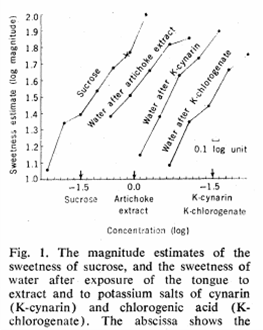(This entry was from 12/22/05 thus the Xmas reference)
Well here I am in rainy Seattle visiting the inlaws. Last night we prepared artichokes for dinner. Naturally the conversation turned to how the consumption of artichoke has a curious effect on the sense of taste: everything tastes sweet even water. If you've never experienced this before it's because you've never had fresh artichoke. Pickled artichoke hearts don't have this property.
So entering "Artichokes and Sweet Taste" into Pubmed what do you get?
Bartoshuk LM, Lee CH, Scarpellino R, Sweet taste of water induced by artichoke (Cynara scolymus). Science. 1972 178(64):988-9.
The authors commented that their research was catalyzed by an AAAS dinner which featured artichokes. Using a tasting assay, the researcher discovered two substances in artichoke that stimulate a sweetening of subsequent ingested substances (such as water), chlorogenic acid (3-caffeoylquinic acid) and cynarin (1,5-dicaffeoylquinic acid).
From the original paper:

In other reseach, these two phenolic compounds have been proposed to
- have antimicrobial activities
- act as anti-oxidants
- upregulate Nitrous Oxide Sythetase in exposed tissue
Searching a bit further, I found this other fruit, miracle fruit (Synsepalum dulcificum), that has similar effects on altering taste. However this time the culprit is a protein, miraculin.
Kurihara K, Beidler LM. Taste-modifying protein from miracle fruit. Science.
1968 161:1241-3
What else could there be? ... searching more I stumbled into this review:
Kurihara Y. Characteristics of antisweet substances, sweet proteins, and
sweetness-inducing proteins. Crit Rev Food Sci Nutr. 1992 32:231-52.Abstract.
Recent studies on structures and functions of sweetness-inhibiting substances (gymnemic acid, ziziphin, and gurmarin); sweet proteins (monellin, thaumatin and mabinlin); and taste-modifying proteins (miraculin and curculin) were reviewed. Several gymnemic acid homologues and gurmarin were purified from the leaves of Gymnema sylvestre and their structures were determined. Ziziphin was also purified from leaves of Ziziphus jujuba. Gymnemic acid and ziziphin are glycoside of triterpenes that suppress sweetness in human, while gurmarin is a peptide having antisweet activity in rat. Mabinlin is a heat-stable sweet protein. The whole amino acid sequence and the position of disulfide bridges of mabinlin were determined. Miraculin has the unusual property of modifying a sour taste into a sweet taste. Curculin elicits a sweet taste. In addition, water and sour substance elicit a sweet taste after curculin. Their amino acid sequences and subunit structures were determined. These proteins are expected to be used as low-calorie sweeteners.
OK enough Pubmed for me. Have a ... sweet ... holiday.
I wonder if some of these components are found in the digestive tract naturally. I've noticed on occasion when I throw up (for whatever reason), I find water tastes sugary for some time after.
Artificial sweetenrs are facinating, but I have yet to find one that appeals to me. Stevia has come closest, but it's got a very strage "profile" on the tounge, and only stimulates a very narrow area of the tounge. Kind of unsatisfying in the morning coffee compared to cane sugar.
It's a kind of old wisdom, a sort of knowledge that only a sophisticated chef possess, that a neat way to make a fruit salad taste sweater without adding any sugar--quite important if you have to serve diabetic people--is to sprinkle the fruit salad with an old fashion liquor called "Cynara" ( brand name). I googled a bit but I haven't come up with anything. I have a couple of bottles I found in a liquor shop in Athens a couple of years ago and I keep them for such occasions. I am certain though that the liquor could be purchased in USA's market as well, since I learned the secret while working in an American kitchen.:-)
So, it's miraculin that does the... miracle!
Cool!
http://www.campari.com/eng/brand/spirits/index.asp?id=30180
here you go...we Italians drink it often.
It is spelled Cynar, without an A at the end.
Ha! Cynar indeed. Thank you so much, rob d. I will have to correct, right away the reference to my blog. So, you still drink it! Cynar neve became quite popular in Greece, it was in fashion in '70ies but I am certain that if people knew the "artichoke fact" would use it more ofter.